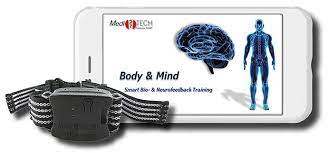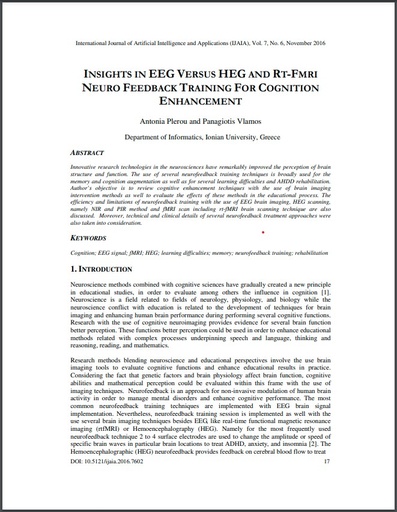
HEG Neurofeedback info channel
Here you will find basic information about HEG neurofeedback. This is a procedure for self-regulation. Unlike conventional EEG neurofeedback, which requires a high degree of self-discipline and especially "sitting still" from the trainee, HEG is extremely easy to use, does not require any pre- and post-processing and is easy for the trainee to understand in its feedback effect.
| Responsible | Ralph Warnke |
|---|---|
| Last Update | 08/13/2024 |
| Completion Time | 1 day 1 hour 35 minutes |
| Mitglieder | 11 |
Share This Course
Share Link
Share on Social Media
Share by Email
Please login to share this HEG Neurofeedback info channel by email.

Innovative research technologies in the neurosciences have remarkably improved the perception of brain structure and function. The use of several neurofeedback training techniques is broadly used for the memory and cognition augmentation as well as for several learning difficulties and AHDD rehabilitation. Author’s objective is to review cognitive enhancement techniques with the use of brain imaging intervention methods as well to evaluate the effects of these methods in the educational process. The efficiency and limitations of neurofeedback training with the use of EEG brain imaging, HEG scanning, namely NIR and PIR method and fMRI scan including rt-fMRI brain scanning technique are also discussed. Moreover, technical and clinical details of several neurofeedback treatment approaches were also taken into consideration.
Publikationen
View allInnovative research technologies in the neurosciences have remarkably improved the perception of brain structure and function. The use of several neurofeedback training techniques is broadly used for the memory and cognition augmentation as well as for several learning difficulties and AHDD rehabilitation. Author’s objective is to review cognitive enhancement techniques with the use of brain imaging intervention methods as well to evaluate the effects of these methods in the educational process. The efficiency and limitations of neurofeedback training with the use of EEG brain imaging, HEG scanning, namely NIR and PIR method and fMRI scan including rt-fMRI brain scanning technique are also discussed. Moreover, technical and clinical details of several neurofeedback treatment approaches were also taken into consideration.
The effectiveness of bio/neurofeedback for ADD and ADHD and similar problems has been proven for a long time. While the previously used technique of neurofeedback is very time-consuming, both in the application and in learning the interpretation of the measured parameters, and also very prone to interference, HEG Feedback offers a revolutionary training opportunity.
Background: The effects of electroencephalography (EEG) and functional magnetic resonance imaging (fMRI)-neurofeedback on brain activation and behaviors have been studied extensively in the past. More recently, researchers have begun to investigate the effects of functional near-infrared spectroscopy-based neurofeedback (fNIRS-neurofeedback). FNIRS is a functional neuroimaging technique based on brain hemodynamics, which is easy to use, portable, inexpensive, and has reduced sensitivity to movement artifacts.
Method: We provide the first systematic review and database of fNIRS-neurofeedback studies, synthesizing findings from 22 peer-reviewed studies (including a total of N = 441 participants; 337 healthy, 104 patients). We (1) give a comprehensive overview of how fNIRS-neurofeedback training protocols were implemented, (2) review the online signal-processing methods used, (3) evaluate the quality of studies using pre-set methodological and reporting quality criteria and also present statistical sensitivity/power analyses, (4) investigate the effectiveness of fNIRS-neurofeedback in modulating brain activation, and (5) review its effectiveness in changing behavior in healthy and pathological populations.
Results and discussion: (1–2) Published studies are heterogeneous (e.g., neurofeedback targets, investigated populations, applied training protocols, and methods). (3) Large randomized controlled trials are still lacking. In view of the novelty of the field, the quality of the published studies is moderate. We identified room for improvement in reporting important information and statistical power to detect realistic effects. (4) Several studies show that people can regulate hemodynamic signals from cortical brain regions with fNIRS-neurofeedback and (5) these studies indicate the feasibility of modulating motor control and prefrontal brain functioning in healthy participants and ameliorating symptoms in clinical populations (stroke, ADHD, autism, and social anxiety). However, valid conclusions about specificity or potential clinical utility are premature.
Conclusion: Due to the advantages of practicability and relatively low cost, fNIRS-neurofeedback might provide a suitable and powerful alternative to EEG and fMRI neurofeedback and has great potential for clinical translation of neurofeedback. Together with more rigorous research and reporting practices, further methodological improvements may lead to a more solid understanding of fNIRS-neurofeedback. Future research will benefit from exploiting the advantages of fNIRS, which offers unique opportunities for neurofeedback research.